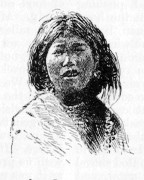Baidarka
Today, a kayak tells us about the Aleut people. The University of Houston's College of Engineering presents this series about the machines that make our civilization run, and the people whose ingenuity created them.
George Dyson's father, Freeman Dyson, was a great English physicist. Once involved with the atom bomb, he later worked with solar sails and interstellar flight. But here in British Columbia son George makes an earthier expression of human ingenuity.
George Dyson is the reigning expert on the subtlest and most complex vehicle ever contrived. He knows more about the baidarka -- the Aleut kayak -- than the Aleut natives themselves did.
Baidarka is a Russian word. The Russians came to the Aleutian Islands in 1732. To the sea north of the Aleutians, they gave the name of their captain -- the moody, stubborn, meticulous Dane, Vitus Bering. But, to the delicate Aleut kayak, they gave their name for a small canoe -- the name baidarka.
A small baidarka is light enough that a child can carry it. It'll capsize if you put it in the water without a passenger. It's a whalebone and driftwood frame covered with sealskin. You have to be a gymnast to get into one. But, once in, you can skim the water at 10 knots. You can land a seal -- even a whale.
Dyson has studied accounts of baidarkas from the past 260 years. The Aleuts have constantly changed and evolved them. They weren't at all conservative about engineering design. A museum curator in Anchorage told me, "The Aleuts were born gadgeteers!"
The baidarka has baffled ethnologists. The prow, for example, is forked with two tines, one above the other. We'd thought that was traditional decoration. Now we see the lower tine is deep and narrow. It cuts into the water and stabilizes the boat. The top is flat --it planes over waves for a smoother ride.
Aleut navigators rode their baidarkas far out to sea -- to California, to the warm Pacific. Aleut legend tells how we know the earth is round. They once sent young men out in two baidarkas. They came back old, without ever having found any edge.
Dyson honors the Aleut mind by mixing experience with experimentation. He's made small baidarkas. He made one that was 48 feet long with sails and outriggers. He tinkers with the shape. He calls the baidarka "a frame of mind." Now he makes them with aluminum tubing and bulkheads -- with nylon skin and lashings.
As those exquisite forms take shape we hear something the great Russian Orthodox missionary, Ivan Veniaminov, once said. He recounted the Aleut ritual of rising in the morning. One must stand, he said, naked,
face to the East, and opening the mouth inhale the light and the air, [and cry] I do not sleep. I am alive. I face you, the life-giving light, and will always live with you.
Dyson's baidarkas are more than boats. They are icons of just that way of life and light -- and buoyancy of the spirit.
I'm John Lienhard, at the University of Houston, where we're interested in the way inventive minds work.
(Theme music)
Dyson, G., Baidarka: The Kayak, Anchorage: Alaska Northwest Books. 1986.
Veniaminov, I., Notes on the Islands of the Unalaska District. (L.T. Black and R.H. Geoghegan, tr.; R.A. Pierce, ed.) Kingston, Ont.: The Limestone Press, 1984. (This includes much Aleut technology including the baidarka.)
See also Episode No. 668 on Veniaminov.
I'm grateful to Walter van Horn, Curator of Collections, and Diane Brenner, Archivist -- both at the Anchorage Museum of History and Art -- for their kind help with this episode.

From the November, 1896, Scribner's Magazine
Sketch of a Native Alaskan from 1896